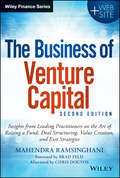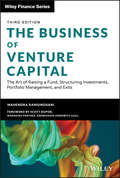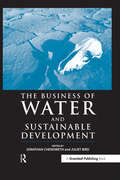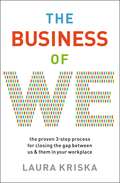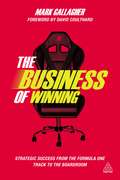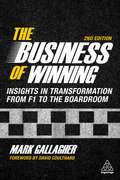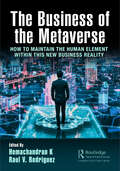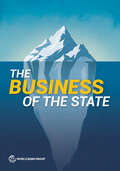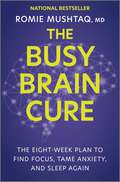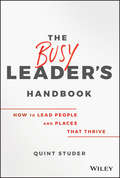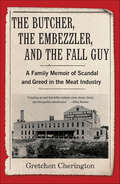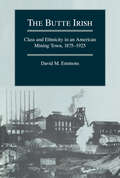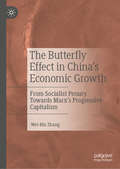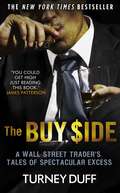- Table View
- List View
The Business of Venture Capital
by Mahendra RamsinghaniThe definitive guide demystifying the venture capital business The Business of Venture Capital covers the entire spectrum of a venture capital business, from raising venture funds to structuring investments, value creation as board member and assessing exit pathways. Author Mahendra Ramsinghani covers the distinct aspects of the venture capital fund raising and investment process with insights and perspectives from leading experts. Interviewees include Limited Partners (LPs) such as Credit Suisse, Grove Street Advisors and General Partners (GPs) from Foundry Group, Spark Capital, Benchmark Capital, Norwest Venture Partners, Shasta Ventures and Bessemer Venture Partners. If you're curious about venture capital businesses, you've found the only book that covers it all. - The first book to address the full investment cycle of the venture capital business - Demystifies the key aspects of the business - raising venture funds, fund-level due diligence and fund terms, structuring investments, value creation, and exits - Foreword by Mark Heesen, President, National Venture Capital Association - Benefit from the experiences of the best-in-class practitioners, who have made investments in leading companies like Zynga, Twitter & Foursquare - Describes how venture capital is an art as well as a science In-depth and thorough, The Business of Venture Capital is the one book that includes insights, tools and real world examples every practitioner can benefit from.
The Business of Venture Capital: The Art of Raising a Fund, Structuring Investments, Portfolio Management, and Exits (Wiley Finance #612)
by Mahendra RamsinghaniThe new edition of the definitive guide for venture capital practitioners—covers the entire process of venture firm formation & management, fund-raising, portfolio construction, value creation, and exit strategies Since its initial publication, The Business of Venture Capital has been hailed as the definitive, most comprehensive book on the subject. Now in its third edition, this market-leading text explains the multiple facets of the business of venture capital, from raising venture funds, to structuring investments, to generating consistent returns, to evaluating exit strategies. Author and VC Mahendra Ramsinghani who has invested in startups and venture funds for over a decade, offers best practices from experts on the front lines of this business. This fully-updated edition includes fresh perspectives on the Softbank effect, career paths for young professionals, case studies and cultural disasters, investment models, epic failures, and more. Readers are guided through each stage of the VC process, supported by a companion website containing tools such as the LP-GP Fund Due Diligence Checklist, the Investment Due Diligence Checklist, an Investment Summary format, and links to white papers and other industry guidelines. Designed for experienced practitioners, angels, devils, and novices alike, this valuable resource: Identifies the key attributes of a VC professional and the arc of an investor’s career Covers the art of raising a venture fund, identifying anchor investors, fund due diligence, negotiating fund investment terms with limited partners, and more Examines the distinct aspects of portfolio construction and value creation Balances technical analyses and real-world insights Features interviews, personal stories, anecdotes, and wisdom from leading venture capitalists The Business of Venture Capital, Third Edition is a must-read book for anyone seeking to raise a venture fund or pursue a career in venture capital, as well as practicing venture capitalists, angel investors or devils alike, limited partners, attorneys, start-up entrepreneurs, and MBA students.
The Business of War: Military Enterprise and Military Revolution in Early Modern Europe
by David ParrottThis is a major new approach to the military revolution and the relationship between warfare and the power of the state in early modern Europe. Whereas previous accounts have emphasized the growth of state-run armies during this period, David Parrott argues instead that the delegation of military responsibility to sophisticated and extensive networks of private enterprise reached unprecedented levels. This included not only the hiring of troops but their equipping, the supply of food and munitions, and the financing of their operations. The book reveals the extraordinary prevalence and capability of private networks of commanders, suppliers, merchants and financiers who managed the conduct of war on land and at sea, challenging the traditional assumption that reliance on mercenaries and the private sector results in corrupt and inefficient military force. In so doing, the book provides essential historical context to contemporary debates about the role of the private sector in warfare.
The Business of Water and Sustainable Development: A Special Themed Issue Of Greener Management International (issue 42)
by Jonathan Chenoweth Juliet BirdA renewed commitment to improved provision of water and sanitation emerged in the 2002 Johannesburg Declaration on Sustainable Development. Although many of the statements in the Declaration were vaguely worded, making it hard to measure progress or success, the Plan of Implementation of the Summit, agreed by the delegates to the conference, clearly stated that: "we agree to halve, by the year 2015, the proportion of people who are unable to reach or to afford safe drinking water and the proportion of people who do not have access to basic sanitation". Given the United Nations' predicted growth in global population from 6.1 billion in 2000 to 7.2 billion by 2015, this commitment will pose formidable challenges. To meet it, by the end of just a decade and half, approximately 6.6 billion people will need to have access to safe drinking water supplies. This is more than the current population of the world, and involves not only maintaining existing levels of supply but also providing new or upgraded services to 1.7 billion people. The challenge for sanitation is equally daunting: 5.8 billion people will need to be serviced, including new access provision for 2.1 billion. Even if these ambitious targets are met, representing a major achievement for the global community, there will still be approximately 650 million people in the world without access to safe drinking water and 1.4 billion without sanitation. What is clear is the magnitude of the problem facing the international community in terms of water supply and sanitation. Continuation of the status quo and the type of progress made during the 1990s will not permit the Johannesburg targets to be met. Instead it will be necessary to promote a combination of many different, new and innovative approaches, each of which will contribute towards the overall targets. These approaches must include technological advances that identify new sources and improve the quality of those already in use; managerial techniques that increase the efficiency and effectiveness of service delivery at both micro and macro scale; and fiscal approaches that tap into additional financial resources to make improvements affordable. In the past each of these aspects was seen as primarily the responsibility of government, which supported research into technology, managed supply and disposal systems and provided the funds to pay for them. This view has changed – beginning in the 1980s and increasing in the 1990s with growing moves towards privatisation of many aspects of the water sector. Underpinning this has been a shift away from seeing water as a public good that is essential for life, with subsidised supply provided as part of an overall welfare system, to a more market-oriented approach where the state, although still responsible for maintaining universal access to water services, uses market forces to meet this aim. The Business of Water and Sustainable Development aims to illustrate the range of approaches that will be necessary if the percentage of the global population having access to adequate and safe water and sanitation is to be increased in line with the brave assertions from Johannesburg World Summit on Sustainable Development. Some of approaches will be large-scale "Western-style" improvements involving the creation of new business models, their effectiveness assessed by traditional approaches of fiscal and social analysis. Such schemes may be instigated and partly funded by governments, but are increasingly turning to the private sector for money and expertise. In contrast, many smaller communities would be better served by following another path to improved water supply and sanitation. Because of their size, location or traditions they may achieve better results through the adoption of local small-scale solutions. Non-governmental organisations have been very active in this area, but to extend their operations many are seeking to adopt a more business-like model. All water supply and waste disposal agencies, large or small, need to support and encourage continued rese
The Business of Watercolour (Routledge Revivals)
by Greg Smith Simon FenwickFirst published in 1997, this volume will revolutionise the study of watercolour painting in Britain. The Royal Watercolour Society archive constitutes a major academic resource covering two hundred years of the history of watercolour painting in Britain. The rediscovery in 1980 of ‘the Jenkins Papers’, the early records of the Society, was a major find for the history of British art. The archives are substantial and remarkably comprehensive. Minutes of annual general meetings, Council and committees, are all intact; extraordinarily, the Society’s catalogues for its own exhibitions have also survived, with details of who bought the pictures and for how much. It contains biographical information on several hundred artists who practised throughout the United Kingdom from the end of the eighteenth century to the present day. Prepared by the archivist to the RWS, Simon Fenwick, this is not just a work of reference, but an absorbing book to dip into again and again.The Society of Painters in Water Colours, as it was then titled, was founded in 1804 to promote the interests of painters using watercolour and to provide a platform for members to sell their work. As such, its archives provide an excellent insight into the evolving debate on the status of the artists and their medium, and an authoritative account of the way in which watercolour paintings were sold, distributed and acquired. The substantial introduction by Greg Smith surveys some of the purposes and practices of watercolour from 1750 to the present day and highlights key issues, many yet to be examined, relating to the study of watercolour. His survey is arranged around a number of topics including the notion of watercolour as a British art, collecting and display, book illustration, architectural drawing, map-making and topography, antiquarian studies, decorative arts, printmaking, portrait miniatures and drawings, amateur practices and the changing status of the sketch.
The Business of We: The Proven Three-Step Process for Closing the Gap Between Us and Them in Your Workplace
by Laura KriskaDiverse teams add tremendous value to any organization… if they work as a cohesive unit. Empower your leaders to bring together teams made up of members from different cultures, age groups, and socio-economic backgrounds.In today&’s workplace, cross-cultural collaboration is essential to the survival of any business. Unfortunately, bringing together people from a variety of backgrounds can lead to &“us vs. them" misunderstandings and clashes that work against the goals of the company. Too often, well-intentioned consultants and HR representatives attempt to solve these problems with a band-aid approach to situations that warrant comprehensive solutions. Diversity in virtually every U.S. organization has increased over the past twenty years, yet the closest we have come to a workplace best practices guide is online diversity training courses or methods of coaching &“problem&” executives to be more sensitive. Neither of these avenues leads to meaningful change. Kriska teaches leaders in any organization how to prevent &“us vs. them" culture clashes by promoting inclusion in their organization to increase employee retention and productivity and to prevent misunderstandings that lead to lost time and increased legal risk.
The Business of Winning
by Mark GallagherIn this riveting insider's account of over thirty years in the Formula One industry, Mark Gallagher explains what it takes to succeed in a competitive business with high technology, high finance and immensely high stakes. Like any global business, Formula One demands the best from its people. To thrive within it requires impeccable leadership and communications skills, as well as the ability to design, manufacture, develop and bring to market a constantly improving high technology product and constantly work to immoveable deadlines with an immense supply chain and tight regulations. With a foreword by former racing champion David Coulthard, The Business of Winning advises on how to deliver in an environment of complex commercial and operational requirements, offering valuable insights on: - branding and image - team building - change management - innovation - global communications strategy The Business of Winning sets out a one-stop management guide for executives keen to emulate this high-speed, high-impact approach to business. Based on hard-won experience and practical examples of how owners, drivers, teams, technicians and sponsors deal with the full range of management questions and issues they face every day, Mark Gallagher brings the drama of the Formula One business to life in vivid detail.
The Business of Winning: Insights in Transformation from F1 to the Boardroom
by Mark GallagherHave you ever wondered what has made Mercedes the undisputed kings of Formula One? Do you want to know how Lewis Hamilton has managed to exceed legendary driver Michael Schumacher's record of winning races? And most of all, do you want to find out how to inject that winning streak to your business strategy? In this riveting insider's account of nearly 40 years in the Formula One industry, Mark Gallagher explains what it takes to succeed in a competitive business with high technology, high finance and immensely high stakes. Like any global business, Formula One demands the best from its people. To thrive within it requires impeccable leadership and communications skills. You also need to bring in the ability to design, manufacture, develop and launch a constantly improving high-technology product, constantly working to immoveable deadlines with an immense supply chain and tight regulations. The Business of Winning sets out a one-stop management guide for business leaders keen to emulate this high-speed, high-impact approach to business. This entirely revised new edition unveils how Formula One is using new technologies to finesse the most minute of details, whilst reaching new audiences, playing its part in sustainability with the aim of being carbon neutral by 2030 and showing the way to diversity and inclusion.
The Business of Yoga: A Guide to Starting, Growing and Marketing Your Yoga Business (Yoga Teaching Guides)
by Katy Appleton Natasha MoutranMany yoga teachers feel overwhelmed when it comes to grappling with the marketing and entrepreneurial aspects of their yoga business. With the market for yoga teachers becoming increasingly saturated, it is crucial that yoga teachers understand what makes their offering unique to implement a focussed business strategy. This part-guide, part workbook helps yoga teachers bridge the gap between the spiritual essence of being a yoga teacher and the financial viability of their business and is based on the authors' two decades worth of experience. Covering everything from the nuts and bolts of starting out as a yoga teacher, to navigating social media there is something for everyone, whether you're just starting out on your journey, or trying to propel your career to the next level.This book is part of the series 'Yoga Teaching Guides', which provides expert information on essential topics as well as ideas for creative teaching.
The Business of the FIFA World Cup
by Simon ChadwickThe FIFA World Cup is arguably the biggest sporting event on earth. This book is the first to focus on the business and management of the World Cup, taking the reader from the initial stages of bidding and hosting decisions, through planning and organisation, to the eventual legacies of the competition. The book introduces the global context in which the World Cup takes place, surveying the history and evolution of the tournament and the geopolitical background against which bidding and hosting decisions take place. It examines all the key issues and debates which surround the tournament, from governance and corruption to security and the media, and looks closely at the technical processes that create the event, from planning and finance to marketing and fan engagement. Analysis of the Women’s World Cup is also embedded in every chapter, and the book also considers the significance of World Cup tournaments at age-group level. No sport business or management course is complete without some discussion of the FIFA World Cup, so this book is essential reading for any student, researcher or sport business professional looking to fully understand global sport business today.
The Business of the Metaverse: How to Maintain the Human Element Within this New Business Reality
by Raul V. Rodriguez K. HemachandranThe metaverse is the future of business applications and models, and this ground-breaking book points and details a complete and clear picture of how the metaverse can impact the various business segments and how the human element will be maintained within the evolutionary change. This book serves as a guide for those planning to implement and expand the metaverse in their business as well as those already using it on limited levels. Simulated intelligence innovation can reveal intricate and significant examples in robust and information-rich situations that posture difficulties for human insight. In addition, similar to other burgeoning advancements, the experience and aptitudes accumulated by vendors and consumers, alongside the steady analysis of interactions and information, empower metaverse calculations to be refined and improved. This book illustrates the current advancements and results and expands the analysis of human-centric metaverse applications to business segments and their future effects on overall enterprise management. Essentially, this book elaborates on the impact of the metaverse across business sectors through the use of case studies.
The Business of the State: Why Going Beyond State-owned Enterprises Matters For Private Sector Development
by World BankThe state, as an owner of businesses, competes and collaborates with the private sector, and this involvement has profound implications for investment and growth. Governments actively participate in commercial markets in different forms, from controlling the production of goods and services to investing in firms as a minority shareholder. The impact of state participation on an economy's growth depends on the type of public-private ownership, the types of markets, and the importance of those markets in the economy. The impact also depends on how policies and institutions regulate both the businesses with state ownership and the markets in which they are active. The Business of the State uses new evidence covering 91 countries from the World Bank's Global Businesses of the State database to highlight the distinction between businesses of the state and traditionally understood state-owned enterprises. The report analyzes how different ownership forms across sectors and institutional settings affect private investment, productivity, technology adoption, and job creation. It also analyzes how government participation in markets influences the ability of economies to respond to shocks, from pandemics to climate change. The report proposes a clear analytical framework for understanding the consequences of relying on businesses of the state to attain specific development goals.
The Busy Brain Cure: The Eight-Week Plan to Find Focus, Tame Anxiety, and Sleep Again
by Romie Mushtaq*A National Bestseller*Noted neurologist and Chief Wellness Officer Dr. Romie Mushtaq reveals the hidden connection between insomnia, anxiety, and adult ADD/ADHD – and gives you a science-backed plan to heal burnout and your Busy Brain in just 8 weeks.Do racing thoughts keep you from falling asleep at night? Is it impossible to focus, even on tasks that used to stimulate you? Are you mindlessly stress-eating throughout the day?These are signs that you have a &“Busy Brain,&” a term coined by triple-board certified physician Dr. Romie Mushtaq to describe a brain riddled with anxiety, insomnia, and ADD/ADHD.Dr. Romie&’s interest in the co-existence of these symptoms began while she was practicing neurology. It deepened after she was rushed into life-saving surgery and finally forced to acknowledge the toll that chronic stress had taken on her life.Determined to heal after conventional medicine failed her, Dr. Romie embarked on a mission to unearth the truth about stress responses in our bodies and brains. The Busy Brain Cure is the culmination of 20+ years of clinical research as a brain doctor and experience in corporate wellness as a Chief Wellness Officer.The book offers a practical, science-based approach to healing your Busy Brain through a straightforward 8-week protocol that anyone can implement. The Busy Brain Cure will show you how to: Improve focus and energy without coffee and stimulants Fall asleep and stay asleep Address the underlying cause of anxiety, insomnia, and adult ADD Manage bloating and stress-eating without a diet or cleanse Treat and heal chronic stress and burnout Alleviate the burnout crisis in your workplaceWith her characteristic wit and sass, Dr. Romie sheds light on the science of chronic stress and neuroinflammation through personal anecdotes and humor. Written for high-performing individuals who need a lasting cure for their Busy Brain, this book is changing the conversation around wellness, success, and performance.
The Busy Girl's Guide to Digital Photography
by Lorna YabsleyThe only complete guide to photography designed specifically for women looking to improve their photography skills for pleasure and profit.With inspirational case studies and examples from professional and semi-pro female photographers, user-friendly technical explanations and image critiques, this book is a practical and useful toolkit for busy girls who enjoy photography. Becoming an accomplished and competent photographer needs to be approached in three stages: Understand your camera and learn how to drive itComposition—tune in and understand your subjectPost-production—share and print However, rather than explain every technical function from the outset, the aim of this book is to demystify the jargon and take you, step by step, back to the basic fundamental principles of photography; first putting you in control of the camera which will, in turn, free up the composition and creativity. The more advanced features of the camera and in-depth processes can be explored once the basic principles are understood. This is a fun, contemporary photography book that will become your essential tool for taking your passion for photography to the next level.
The Busy Leader's Handbook: How To Lead People and Places That Thrive
by Quint StuderA comprehensive book of “need-to-know” insights for busy leaders Being a great leader means getting the fundamentals right. It also means consistently doing the “little things” that make a positive difference in the lives of employees, customers, and other stakeholders. The Busy Leader’s Handbook: How to Lead People and Places That Thrive is a practical, easy-to-use book filled with gentle reminders of what we should be doing every day—especially when work is at its most intense. The Handbook is packed with proven best practices, tools, tips, and tactics for engaging employees, revitalizing cultures, delighting customers, and building high-performance companies. Short, succinct, and accessible, each chapter is “stand-alone,” offering helpful advice for meeting common business challenges. Plus, the strategies, approaches, and tactics are designed to be put into action immediately. Best-selling author, businessman, visionary, and entrepreneur Quint Studer draws on his 30-plus years of experience in helping organizations of all sizes and leaders at every level reach peak performance. Comprehensive in scope, his book overflows with insights and practical advice to help you make smart leadership decisions. For example: Why putting the right foundational structures in place early on creates clarity and heads off problems that cause businesses to struggle and fail The importance of followership: why being a good leader requires that you first be a good follower Why we tend to run from self-disruption and a sense of being unsettled (and how to learn to embrace them instead) Why leaders should seek consent, not consensus How to engage employees and create a positive workplace culture How to help employees find meaning and purpose in their work How to conduct difficult conversations and resolve conflicts—and why having these skills (or not) can make or break you as a leader Advice for attracting and hiring the best talent, retaining them over time, and dealing with the low performers who drive them away Why mentoring is so powerful and how to encourage it inside your company Tips and tactics for seeing the world through your customer’s eyes How to reduce customer anxiety (and encourage them to buy) with the right words at the right times for the right reasons The Busy Leader’s Handbook functions as a desk reference and pocket guide for anyone in a leadership position. It’s also a great training tool for onboarding new leaders. Whether you work for a start-up, a small or mid-size business, or a large corporation, this book will change how you think, inspire you to do your job better—and help your organization thrive.
The Busy Manager's Guide to Delegation (WorkSmart)
by Richard Luecke Perry McIntoshDelegation amounts to a lot more than just passing work off onto subordinates, and when handled correctly, it gives managers a chance to lead more effectively.Authors Richard A. Luecke and Perry Mcintosh present leaders with a straightforward, five-step process for mastering delegation--and increasing their output. The Busy Manager&’s Guide to Delegation teaches you to set the stage for excellent results, what to do if things go wrong, and ways to ensure that all their people benefit from the experience.In this book, you&’ll discover:which tasks to delegate;how to identify the right people for the jobs;how to assign tasks;how to monitor progress and provide feedback;and how to evaluate performance.Filled with quick tips, exercises, self-assessments, and practical worksheets, The Busy Manager&’s Guide to Delegation offers busy managers a way to strengthen their departments by focusing their newfound time and energy on developing the skills of their people.
The Butcher, the Embezzler, and the Fall Guy: A Family Memoir of Scandal and Greed in the Meat Industry
by Gretchen CheringtonThree powerful men converge on the banks of the Red Cedar River in the early 1900s in southern Minnesota—George Albert Hormel, founder of what will become the $10 billion food conglomerate Hormel Foods; Alpha LaRue Eberhart, the author’s paternal grandfather and Hormel’s Executive Vice President and Corporate Secretary; and Ransome Josiah Thomson, Hormel’s comptroller. Over ten years, Thomson will embezzle $1.2 million from the company’s coffers, nearly bringing the company to its knees.The Butcher, The Embezzler, and The Fall Guy opens in 1922 as George Hormel calls Eberhart into his office and demands his resignation. Hailed as the true leader of the company he’d helped Hormel build—is Eberhart complicit in the embezzlement? Far worse than losing his job and the great wealth he’d rightfully accumulated is that his beloved young wife, Lena, is dying while their three children grieve alongside. Of course, his story doesn’t end there. In scale both intimate and grand, Cherington deftly weaves the histories of Hormel, Eberhart, and Thomson within the sweeping landscape of our country’s early industries, along with keen observations about business leaders gleaned from her thirty-five-year career advising top company executives. The Butcher, The Embezzler, and The Fall Guy equally chronicles Cherington’s journey from blind faith in family lore to a nuanced consideration of the three men’s great strengths and flaws—and a multilayered, thoughtful exploration of the ways we all must contend with the mythology of powerful men, our reverence for heroes, and the legacy of a complicated past.
The Butte Irish: Class and Ethnicity in an American Mining Town, 1875-1925 (Statue of Liberty Ellis Island)
by David M. EmmonsIn this pioneering study, David Emmons tells the story of Butte's large and assertive population of Irish immigrants. He traces their backgrounds in Ireland, the building of an ethnic community in Butte, the nature and hazards of their work in the copper mines, and the complex interplay between Irish nationalism and worker consciousness. From a treasure trove of "Irish stuff," the reports, minutes, and correspondence of the major Irish-American organizations in Butte, Emmons shows how the stalwart supporters of the RELA and the Ancient Order of Hiberians marched and drilled for Irish freedom---and how, as they ran the town, the miners' union, and the largest mining companies, they used this tradition of ethnic cooperation to ensure safe and steady work, Irish mines taking care of Irish miners. Butte was new, overwhelmingly Irish, and extraordinarily dangerous---the ideal place to test the seam between class and ethnicity.
The Butterfly Defect: How Globalization Creates Systemic Risks, and What to Do about It
by Ian Goldin Mike MariathasanHow to better manage systemic risks—from cyber attacks and pandemics to financial crises and climate change—in a globalized worldThe Butterfly Defect addresses the widening gap between the new systemic risks generated by globalization and their effective management. It shows how the dynamics of turbo-charged globalization has the potential and power to destabilize our societies. Drawing on the latest insights from a wide variety of disciplines, Ian Goldin and Mike Mariathasan provide practical guidance for how governments, businesses, and individuals can better manage globalization and risk.Goldin and Mariathasan demonstrate that systemic risk issues are now endemic everywhere—in supply chains, pandemics, infrastructure, ecology and climate change, economics, and politics. Unless we address these concerns, they will lead to greater protectionism, xenophobia, nationalism, and, inevitably, deglobalization, rising inequality, conflict, and slower growth.The Butterfly Defect shows that mitigating uncertainty and risk in an interconnected world is an essential task for our future.
The Butterfly Effect in China’s Economic Growth: From Socialist Penury Towards Marx’s Progressive Capitalism
by Wei-Bin ZhangThis book examines the butterfly effect in China's modern economic development during the period of 1978–2018. In chaos theory, the butterfly effect refers to a phenomenon that a butterfly flaps its wings in Okinawa, and subsequently a storm may ravage New York. Deng applied a trivial idea, called the market mechanism, to China’s countryside in 1978. The idea has subsequently caused economic structural changes and fast growth in the economy with the largest population in human history. China’s per capita GDP jumped from $100 in 1978 to over US$8,000 in 2018. Eight hundred million people have made a great escape from poverty. By 2018, China was the world’s second-largest economy from its 10th position in 1978 with its 9 per cent average annual growth rate of GDP in the previous four decades. This illuminating book will be of value to economists, scholars of China, and historians.
The Butterfly Effect in Competitive Markets
by RajagopalThis book provides an introduction to the concept of entrepreneurship and entrepreneurial business management. It covers many elements of the entrepreneurial management discipline including choosing a business, organizing, financing, marketing, developing an offering that the market will value, and growing the business in all its dimensions.
The Buy Right Approach to Property Investing: Mastering the skills to invest wisely in property
by Pete Wargent Cate BakosThe basic premise of this book is that the best time to sell property is never – provided you buy the right property in the first place. The Buy Right Approach to Property Investing will help you to achieve a passive income and financial freedom through investing in Australian property. Cate and Pete's industry knowledge of Australian property investing shines through with detailed reflections on a multitude of investor successes and mistakes. Importantly, they outline what's involved in buying the right property, which includes: • doing your due diligence on areas, properties and price • researching historical capital growth and performance • calculating your return on investment • adopting a cautiously optimistic outlook and long-term view • managing your risk. Their mission is to demystify much of the jargon in the world of real estate and enable readers not only to better understand and relate to property investment goals but to embrace their confidence and take sensible, well-informed action.
The Buy Side
by Turney DuffThe Buy Side, by former Galleon Group trader Turney Duff, portrays an after-hours Wall Street culture where drugs and sex are rampant and billions in trading commissions flow to those who dangle the most enticements. A remarkable writing debut, filled with indelible moments, The Buy Side shows as no book ever has the rewards - and dizzying temptations - of making a living on the Street. Growing up in the 1980's Turney Duff was your average kid from Kennebunk, Maine, eager to expand his horizons. After trying - and failing - to land a job as a journalist, he secured a trainee position at Morgan Stanley and got his first feel for the pecking order that exists in the trading pits. Those on the "buy side," the traders who make large bets on whether a stock will rise or fall, are the "alphas" and those on the "sell side," the brokers who handle their business, are eager to please. How eager to please was brought home stunningly to Turney in 1999 when he arrived at the Galleon Group, a colossal hedge-fund management firm run by secretive founder Raj Rajaratnam. Finally in a position to trade on his own, Turney was encouraged to socialize with the sell side and siphon from his new broker friends as much information as possible. Soon he was not just vacuuming up valuable tips but also being lured into a variety of hedonistic pursuits. Naïve enough to believe he could keep up the lifestyle without paying a price, he managed to keep an eye on his buy-and-sell charts and, meanwhile, pondered the strange goings on at Galleon, where tens of millions were being made each week in sometimes mysterious ways. At his next positions, at Argus Partners and J.L. Berkowitz, Turney climbed to even higher heights - and, as it turned out, plummeted to even lower depths - as, by day, he solidified his reputation one of the Street's most powerful healthcare traders, and by night, he blazed a path through the city's nightclubs, showing off his social genius and voraciously inhaling any drug that would fill the void he felt inside. A mesmerizingly immersive journey through Wall Street's first millennial decade, and a poignant self portrait by a young man who surely would have destroyed himself were it not for his decision to walk away from a seven-figure annual income, The Buy Side is one of the best coming-of-age-on-the-Street books ever written.From the Hardcover edition.
The Buy Side: A Wall Street Trader's Tale of Spectacular Excess
by Turney DuffThe Buy Side is Turney Duff's high-adrenaline journey through the trading underworld, as well as a searing look at an after-hours Wall Street culture where sex and drugs are the quid pro quo and a billion isn't enough. In the mid-2000's, Turney Duff was, to all appearances, the very picture of American success. One of Wall Street's hottest traders, he was a rising star with Raj Rajaratnam's legendary Galleon Group before forging his own path. What few knew was that the key to Turney's remarkable success wasn't a super-genius IQ or family connections but rather a winning personality - because the real money wasn't made on the trading floor or behind a computer screen, but in whispered deals in the city's most exclusive nightspots, surrounded by the best drugs and hottest women. For Turney, this created a perilously seductive cycle: the harder he partied, the more connected and successful he became, which meant he could party even harder. In time, he became a walking paradox, an addictive mess after hours, and King of the Street from nine to five. Along the way, he learned some important lessons about himself, and the too-wild-to-believe world of Wall Street trading. In The Buy Side, the money is plentiful and the after-hours indulgence even more so, which has proved to be a bestselling and box office winning combination, as the success of The Wolf of Wall Street attests. Fans of Martin Scorsese's film and Michael Lewis's Liar's Poker and The Big Short will want to take a walk on The Buy Side.
The Buy To Let Manual (3rd Edition): How To Invest For Profit In Residential Property And Manage The Letting Yourself
by Tony BoothThis highly-praised book provides the reader with everything that needs to be known about buying, preparing and letting a suitable investment property in the UK. <P><P>The Buy to Let Manual, now in its third edition, is a comprehensive, yet clear and concise guide for the world-be, go-it-alone landlord who wishes to avoid agency fees by creating and managing his own tenancy. Inside you will learn how to identify profitable residential investments, how to advertise your letting and manage the subsequent tenancy yourself.
